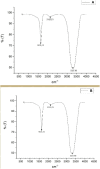Investigation of Antimicrobial and Cytotoxic Properties and Specification of Silver Nanoparticles (AgNPs) Derived From Cicer arietinum L. Green Leaf Extract
- PMID: 35330628
- PMCID: PMC8940290
- DOI: 10.3389/fbioe.2022.855136
Investigation of Antimicrobial and Cytotoxic Properties and Specification of Silver Nanoparticles (AgNPs) Derived From Cicer arietinum L. Green Leaf Extract
Abstract
Using biological materials to synthesize metallic nanoparticles has become a frequently preferred method by researchers. This synthesis method is both fast and inexpensive. In this study, an aqueous extract obtained from chickpea (Cicer arietinum L.) (CA) leaves was used in order to synthesize silver nanoparticles (AgNPs). For specification of the synthesized AgNPs, UV-vis spectrophotometer, Fourier transform infrared spectroscopy (FT-IR), X-ray diffraction analysis (XRD), transmission electron microscopy (TEM), scanning electron microscopy (SEM), electron dispersive X-ray (EDX), and zeta potential (ZP) analyses data were used. Biologically synthesized AgNPs demonstrated a maximum surface plasmon resonance of 417.47 nm after 3 h. With the powder XRD model, the mean crystallite dimension of nanoparticles was determined as 12.17 mm with a cubic structure. According to the TEM results, the dimensions of the obtained silver nanoparticles were found to be 6.11-9.66 nm. The ZP of the electric charge on the surface of AgNPs was measured as -19.6 mV. The inhibition effect of AgNPs on food pathogen strains and yeast was determined with the minimum inhibition concentration (MIC) method. AgNPs demonstrated highly effective inhibition at low concentrations especially against the growth of B. subtilis (0.0625) and S. aureus (0.125) strains. The cytotoxic effects of silver nanoparticles on cancerous cell lines (CaCo-2, U118, Sk-ov-3) and healthy cell lines (HDF) were revealed. Despite the increase of AgNPs used against cancerous and healthy cell lines, no significant decrease in the percentage of viability was detected.
Keywords: SEM-EDX; cytotoxic activity; food pathogens; green synthesis; nanomaterials; nanomedicine.
Copyright © 2022 Baran, Fırat Baran, Keskin, Hatipoğlu, Yavuz, İrtegün Kandemir, Adican, Khalilov, Mammadova, Ahmadian, Rosić, Selakovic and Eftekhari.
Conflict of interest statement
The authors declare that the research was conducted in the absence of any commercial or financial relationships that could be construed as a potential conflict of interest.
Figures









References
-
- Abu-Elghait M., Hasanin M., Hashem A. H., Salem S. S. (2021). Ecofriendly Novel Synthesis of Tertiary Composite Based on Cellulose and Myco-Synthesized Selenium Nanoparticles: Characterization, Antibiofilm and Biocompatibility. Int. J. Biol. Macromolecules 175, 294–303. 10.1016/j.ijbiomac.2021.02.040 - DOI - PubMed
-
- Aktepe N., Baran A. (2021). Fast and Low Cost Biosynthesis of AgNPs with almond Leaves: Medical Applications with Biocompatible Structures. Progr Nutr. 23, e2021271. 10.23751/pn.v23i3.11996 - DOI
-
- Amer M. I., Moustafa S. H., El-Hagary M. (2020). Enhanced Band Structure, Optoelectronic and Magnetic Properties of spray Pyrolysis Ni-Doped SnO2 Nanostructured Films. Mater. Chem. Phys. 248, 122892. 10.1016/j.matchemphys.2020.122892 - DOI
-
- Asadi N., Annabi N., Mostafavi E., Anzabi M., Khalilov R., Saghfi S., et al. (2018). Synthesis, Characterization and In Vitro Evaluation of Magnetic Nanoparticles Modified with PCL-PEG-PCL for Controlled Delivery of 5FU. Artif. Cell Nanomedicine, Biotechnol. 46, 938–945. 10.1080/21691401.2018.1439839 - DOI - PubMed
LinkOut - more resources
Full Text Sources
Research Materials

